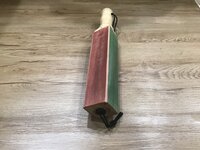S-3 ranch
WKR
I've tried it with high polished, 100k edges and with coarse edges as well, ended up choosing coarse edge, lasts a lot longer, especially on highly abrasive mediums.
sharpen with 800-1000 grit diamond stone, then strop or ceramic stick to maintain the edge, resharping in the woods or mountains sux
sharpen with 800-1000 grit diamond stone, then strop or ceramic stick to maintain the edge, resharping in the woods or mountains sux



